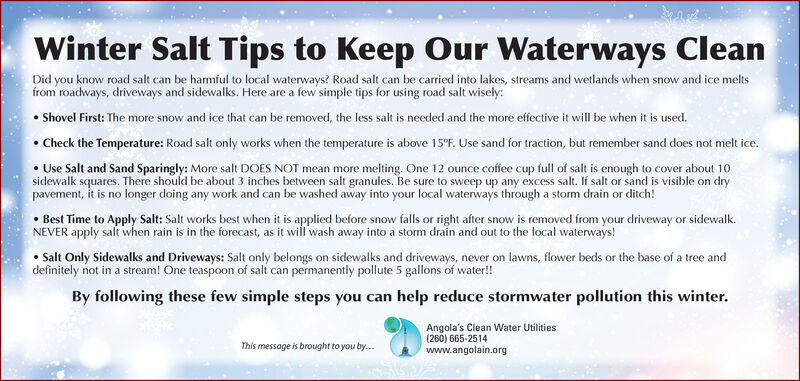Advertisement

-
Published Date
January 25, 2020This ad was originally published on this date and may contain an offer that is no longer valid. To learn more about this business and its most recent offers, click here.
Ad Text
Winter Salt Tips to Keep Our Waterways Clean Did you know road salt can be harmful to local waterways? Road salt can be carried into lakes, streams and wetlands when snow and ice melts from roadways, driveways and sidewalks. Here are a few simple tips for using road salt wisely: Shovel First: The more snow and ice that can be removed, the less salt is needed and the more effective it will be when it is used. Check the Temperature: Road salt only works when the temperature is above 15°F. Use sand for traction, but remember sand does not melt ice. Use Salt and Sand Sparingly: More salt DOES NOT mean more melting. One 12 ounce coffee cup full of salt is enough to cover about 10 sidewalk squares. There should be about 3 inches between salt granules. Be sure to sweep up any excess salt. If salt or sand is visible on dry pavement, it is no longer doing any work and can be washed away into your local waterways through a storm drain or ditch! Best Time to Apply Salt: Salt works best when it is applied before snow falls or right after snow is removed from your driveway or sidewalk. NEVER apply salt when rain is in the forecast, as it will wash away into a storm drain and out to the local waterways! Salt Only Sidewalks and Driveways: Salt only belongs on sidewalks and driveways, never on lawns, flower beds or the base of a tree and definitely not in a stream! One teaspoon of salt can permanently pollute 5 gallons of water!! By following these few simple steps you can help reduce stormwater pollution this winter. Angola's Clean Water Utilities (260) 665-2514 www.angolain.org This message is brought to you by... Winter Salt Tips to Keep Our Waterways Clean Did you know road salt can be harmful to local waterways? Road salt can be carried into lakes, streams and wetlands when snow and ice melts from roadways, driveways and sidewalks. Here are a few simple tips for using road salt wisely: Shovel First: The more snow and ice that can be removed, the less salt is needed and the more effective it will be when it is used. Check the Temperature: Road salt only works when the temperature is above 15°F. Use sand for traction, but remember sand does not melt ice. Use Salt and Sand Sparingly: More salt DOES NOT mean more melting. One 12 ounce coffee cup full of salt is enough to cover about 10 sidewalk squares. There should be about 3 inches between salt granules. Be sure to sweep up any excess salt. If salt or sand is visible on dry pavement, it is no longer doing any work and can be washed away into your local waterways through a storm drain or ditch! Best Time to Apply Salt: Salt works best when it is applied before snow falls or right after snow is removed from your driveway or sidewalk. NEVER apply salt when rain is in the forecast, as it will wash away into a storm drain and out to the local waterways! Salt Only Sidewalks and Driveways: Salt only belongs on sidewalks and driveways, never on lawns, flower beds or the base of a tree and definitely not in a stream! One teaspoon of salt can permanently pollute 5 gallons of water!! By following these few simple steps you can help reduce stormwater pollution this winter. Angola's Clean Water Utilities (260) 665-2514 www.angolain.org This message is brought to you by...
